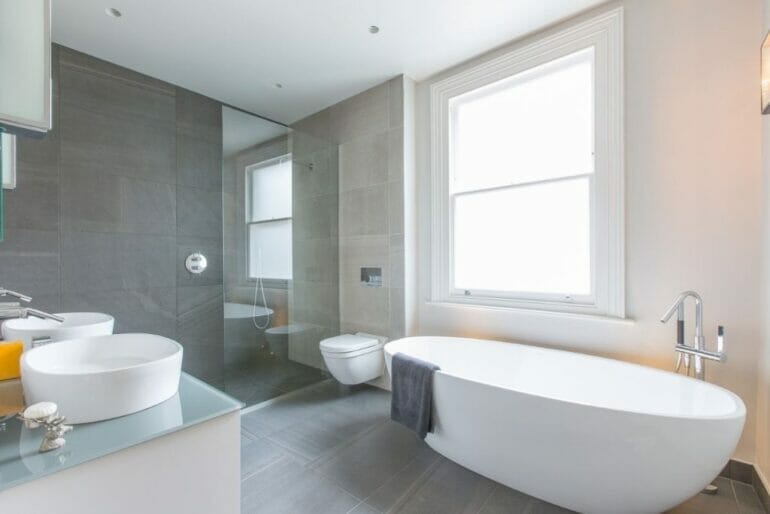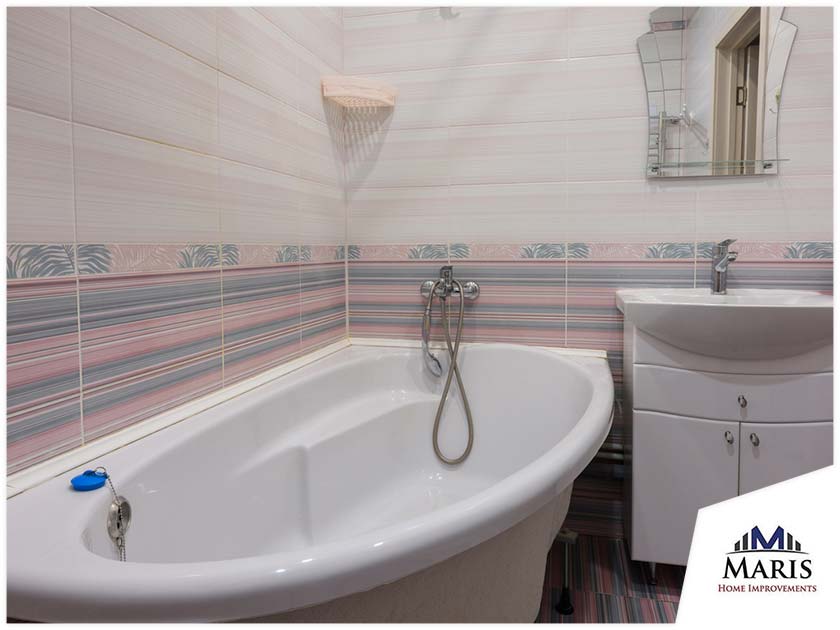When it comes to choosing between a porcelain tub and an acrylic tub, there are a few factors to consider.
Porcelain tubs are known for their classic and elegant appearance, providing a timeless appeal to any bathroom. Acrylic tubs, on the other hand, are lightweight and easy to install, making them a popular choice for homeowners.
In terms of durability, porcelain tubs are highly resistant to scratches and stains, making them a long-lasting option. Acrylic tubs, although less resistant to damage, offer better heat retention and are more affordable.
Ultimately, the choice between a porcelain tub and an acrylic tub depends on your personal preferences and budget. Consider your needs, style preferences, and maintenance requirements to make an informed decision.

1. Material Composition
Porcelain tubs are made of a fused glass and metal material known for its hardness and durability. The porcelain enamel is fused onto a cast iron or steel base, creating a solid and strong bathtub. On the other hand, acrylic tubs are made of a lightweight and flexible material that is prone to scratches, cracks, and fading over time.2. Resistance to Stains and Chemicals
Porcelain tubs have a non-porous surface that is resistant to stains, chemicals, and discoloration. This makes them easier to clean and maintain their pristine appearance for a longer period. Acrylic tubs, on the other hand, can be easily stained and damaged by harsh chemicals and abrasive cleaners, leading to a shorter lifespan.3. Heat Retention
Porcelain tubs have excellent heat retention properties, which means that they can keep the water warmer for a longer time. This is especially beneficial for those who enjoy long and relaxing baths. Acrylic tubs, however, do not retain heat as well as porcelain tubs, requiring more frequent refilling with hot water.4. Impact Resistance
Porcelain tubs are highly resistant to impact and are less likely to crack or chip when compared to acrylic tubs. This makes them a better choice for households with children or pets, where accidental drops or impacts may occur. Acrylic tubs, being more flexible, are more susceptible to damage from heavy impacts.5. Longevity
Porcelain tubs have a longer lifespan compared to acrylic tubs. With proper care and maintenance, a porcelain tub can last for decades. The durable nature of porcelain ensures that it can withstand regular use without showing signs of wear and tear. On the other hand, acrylic tubs are more prone to discoloration, fading, and surface damage over time, requiring replacement sooner. In summary, porcelain tubs excel over acrylic in terms of durability and longevity. The material composition, resistance to stains and chemicals, heat retention, impact resistance, and overall lifespan make porcelain tubs a superior choice. Investing in a porcelain tub ensures that you will have a durable and long-lasting bathtub for years to come.
Maintenance and Cleaning: The hassle-free benefits of an acrylic tub
When it comes to bathroom fixtures, one of the most popular options is an acrylic tub. Not only does it provide a sleek and modern look to any bathroom, but it also offers a number of maintenance and cleaning benefits that make it a top choice for homeowners. In this section, we will explore the hassle-free benefits of an acrylic tub and why it is a great investment for your bathroom.
Ease of Cleaning
Acrylic tubs are incredibly easy to clean. Unlike other materials such as cast iron or porcelain, acrylic tubs do not require harsh chemicals or abrasive cleaners to keep them looking pristine. In fact, all you need is a mild soap and water solution to wipe away any dirt or stains. The non-porous surface of acrylic prevents dirt and grime from penetrating, making it a breeze to clean and maintain.
Durability
Acrylic tubs are known for their durability. They are resistant to cracking, chipping, and fading, ensuring that your tub will look as good as new for years to come. This is particularly important for high-traffic bathrooms or homes with children, as acrylic tubs can withstand the wear and tear of daily use without showing signs of damage.
Stain Resistance
One of the key benefits of an acrylic tub is its stain resistance. The non-porous surface repels stains, preventing them from setting in and becoming permanent. This means that even if you accidentally spill a colored substance, such as hair dye or nail polish, you can easily wipe it away without worrying about it leaving a lasting mark.
Low Maintenance
Unlike other materials that require regular maintenance and refinishing, acrylic tubs are virtually maintenance-free. They do not require any special treatments or coatings to maintain their appearance. Simply clean your acrylic tub regularly and it will continue to look beautiful for years to come.
Scratch Resistance
Another advantage of acrylic tubs is their scratch resistance. The material is designed to be tough and resilient, making it less susceptible to scratches and scuffs. This is especially beneficial for households with pets or young children, as acrylic tubs can withstand accidental scratches without compromising their appearance.
Easy Repairs
In the rare event that your acrylic tub does sustain damage, such as a small chip or scratch, repairs are relatively simple. Acrylic can be easily repaired using a repair kit, eliminating the need for expensive replacements or professional repairs.
Longevity
Thanks to their durability and low maintenance requirements, acrylic tubs have a long lifespan. With proper care, an acrylic tub can last for many years, providing you with a reliable and stylish bathing solution.
In summary, opting for an acrylic tub offers numerous hassle-free benefits. From easy cleaning and durability to stain resistance and low maintenance, acrylic tubs are a practical and stylish choice for any bathroom. Consider investing in an acrylic tub to enjoy a hassle-free bathing experience for years to come.

Cost Considerations: Is porcelain worth the investment?
When it comes to choosing the right material for your home renovation or construction project, cost is always a crucial factor to consider. Porcelain is known for its durability, elegance, and versatility, but is it worth the investment? Let’s take a closer look at the cost considerations of using porcelain.
1. Initial Cost
Porcelain tiles are generally more expensive compared to other flooring options like ceramic or vinyl. The initial cost of purchasing porcelain tiles can be higher, but it’s important to remember that porcelain offers long-term benefits that justify the investment.
Porcelain tiles are made from high-quality clay and fired at high temperatures, resulting in a dense and hard-wearing material. This durability ensures that your porcelain floors or walls will last for many years, reducing the need for frequent replacements or repairs.
2. Installation Costs
The installation costs of porcelain tiles can vary depending on various factors, such as the complexity of the project, the size of the area, and the type of porcelain chosen. Generally, porcelain tiles require professional installation due to their weight and precise placement requirements.
While the installation costs may be higher compared to other flooring options, the long-term benefits of porcelain make it a worthwhile investment. Properly installed porcelain tiles can withstand heavy foot traffic, resist stains, and maintain their appearance for years to come. This saves you money on future repairs or replacements.
3. Maintenance and Durability
Porcelain is known for its exceptional durability and low maintenance requirements. This can lead to long-term cost savings. Porcelain tiles are resistant to scratches, stains, and wear, making them suitable for high-traffic areas such as kitchens and bathrooms.
Additionally, porcelain is highly resistant to moisture and temperature changes, making it perfect for both indoor and outdoor installations. Its low water absorption rate prevents warping or damage caused by water exposure, reducing the risk of costly repairs or replacements.
4. Longevity and Resale Value
Investing in porcelain can also add value to your property. Due to its durability and timeless aesthetic appeal, porcelain can enhance the overall value of your home. Potential buyers often perceive porcelain as a premium and luxurious material, which can increase the resale value of your property.
Furthermore, porcelain’s longevity ensures that your investment will last for several decades, making it a cost-effective choice in the long run. When properly cared for, porcelain tiles can maintain their original beauty and functionality for many years, saving you money on potential renovations or replacements down the line.
5. Consider Your Budget and Priorities
While porcelain may have a higher upfront cost compared to other materials, its long-term benefits and durability make it a worthwhile investment. However, it’s essential to consider your budget and priorities before making a final decision.
If cost is your primary concern, there are alternative flooring options available that may better suit your budget. However, keep in mind that the long-term expenses associated with maintenance, repairs, and replacements may outweigh the initial cost savings.
In summary, porcelain is worth the investment due to its durability, low maintenance requirements, and timeless appeal. Although it may have a higher upfront cost, its long-term benefits and ability to enhance the value of your property make it a wise choice.
Factors to Consider When Choosing Between Porcelain and Acrylic Tubs
When it comes to selecting a new tub for your bathroom, there are several factors to consider, including the material of the tub. Two popular options that you’ll come across are porcelain and acrylic tubs. Both have their own unique features and advantages, so it’s essential to understand the differences between them to make an informed decision. Here are some key factors to consider when choosing between porcelain and acrylic tubs:
Durability
One of the primary considerations when selecting a tub is its durability. Porcelain tubs are known for their exceptional strength and durability. Porcelain is a type of ceramic that is fired at high temperatures, making it resistant to chipping, staining, and scratching. It is a long-lasting material that can withstand regular use and maintain its appearance for years to come.
On the other hand, acrylic tubs are made from a material called fiberglass-reinforced plastic. While acrylic is generally durable, it may not be as strong as porcelain. Acrylic tubs are prone to scratching, fading, and discoloration over time. However, with proper care and maintenance, they can last for a significant period.
Weight and Installation
The weight of the tub is an important consideration, especially if you’re replacing an existing tub or installing one in an upper-level bathroom. Porcelain tubs are considerably heavier compared to acrylic tubs due to the nature of the material. They require sturdy flooring and additional support during installation.
Acrylic tubs, on the other hand, are lightweight and easier to install. They can be installed on most types of flooring without the need for additional support. The lightweight nature of acrylic tubs also makes them a suitable option for older or weaker bathroom structures.
Heat Retention
Another factor to consider is how well the tub retains heat. Porcelain tubs have excellent heat retention properties, allowing you to enjoy a warm and relaxing bath for a more extended period. The dense and heavy nature of porcelain helps to keep the water warm for longer.
Acrylic tubs, on the other hand, have lower heat retention capabilities compared to porcelain. The lightweight and non-porous nature of acrylic may cause the water to cool down faster, requiring additional hot water to maintain the desired temperature.
Aesthetics
When it comes to aesthetics, both porcelain and acrylic tubs offer various design options to suit your personal preferences. Porcelain tubs have a classic and elegant look that can enhance the overall aesthetic of your bathroom. They come in a variety of colors, including white, black, and even custom colors to match your bathroom decor.
Acrylic tubs, on the other hand, offer more versatility in terms of design. They are available in a wide range of shapes, sizes, and colors. Acrylic can also be molded into different shapes, allowing for unique and modern designs that can complement any bathroom style.
Maintenance
Keeping your tub clean and well-maintained is essential for its longevity. Porcelain tubs are relatively easy to clean and maintain. They are resistant to stains and can be cleaned using mild cleansers without worrying about damaging the surface.
Acrylic tubs require regular cleaning and special care to prevent scratches and maintain their appearance. Abrasive cleaners should be avoided as they can cause damage to the acrylic surface. It’s important to follow the manufacturer’s guidelines for cleaning and maintenance to keep the tub looking its best.
Cost
The cost of the tub is another important factor to consider. Generally, acrylic tubs are more budget-friendly compared to porcelain tubs. The manufacturing process of acrylic allows for more affordable options without compromising on quality. Porcelain tubs, on the other hand, tend to be more expensive due to their durability and premium aesthetic appeal.
Summary
When choosing between porcelain and acrylic tubs, several factors need to be considered. Porcelain tubs offer exceptional durability, heat retention, and a classic aesthetic. They are heavier and more expensive compared to acrylic tubs.
Acrylic tubs, on the other hand, are lightweight, easy to install, and available in a wider range of designs. They require more maintenance to prevent scratches and fading, but are more budget-friendly.
Ultimately, the choice between porcelain and acrylic tubs depends on your personal preferences, budget, and specific requirements for your bathroom. Consider these factors carefully to make the best decision for your needs and enjoy a luxurious bathing experience for years to come.
FAQs
Is a porcelain tub better than an acrylic tub?
Both porcelain and acrylic tubs have their own advantages. Porcelain tubs are durable and resistant to scratches and stains, but they can be more expensive and are prone to chipping. Acrylic tubs are lightweight, affordable, and easier to maintain, but they are more prone to scratches and may not last as long as porcelain tubs.
Conclusion
In conclusion, when it comes to choosing between a porcelain tub and an acrylic tub, both have their own advantages. Porcelain tubs are known for their classic and elegant appearance, as well as their durability and resistance to scratches. On the other hand, acrylic tubs offer a lightweight and affordable option, as well as a wider variety of shapes and sizes to choose from.
Ultimately, the choice between a porcelain tub and an acrylic tub depends on your personal preferences and needs. If you prioritize aesthetics and durability, a porcelain tub may be the better choice. However, if budget and versatility are your primary concerns, an acrylic tub might be the more suitable option.
Regardless of your choice, both types of tubs can provide a luxurious and relaxing bathing experience, and with proper care and maintenance, they can last for many years to come.
